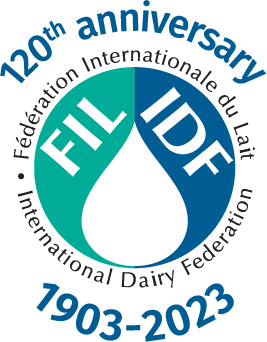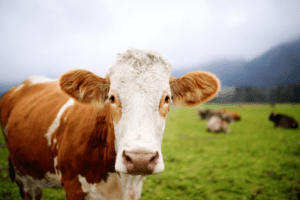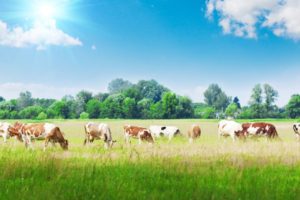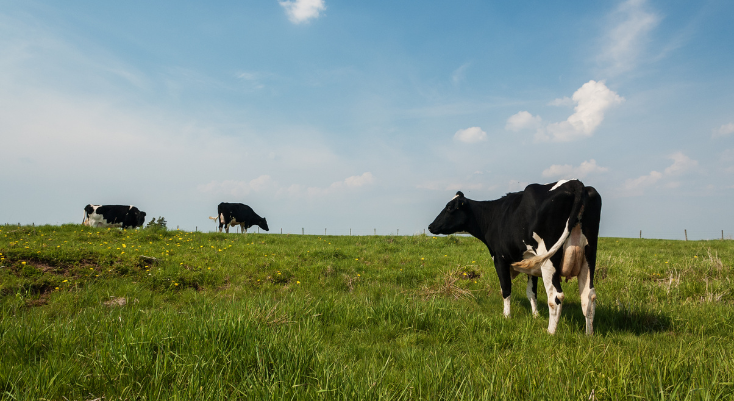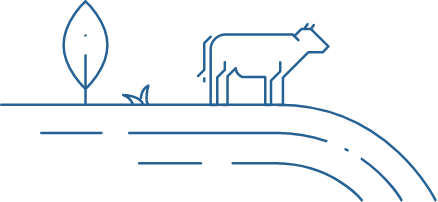Share this page
Life cycle assessment of the dairy sector

Life Cycle Assessment methodology was originally used to analyse industrial process chains but has been adapted over the past 20 years to assess the environmental impacts of agriculture, although to date, it has mainly been employed in arable agriculture and less in livestock farming.
Life Cycle Assessment (LCA) is an acknowledged environmental impact assessment tool to calculate greenhouse gas (GHG) emissions of dairy production. The LCA method systematically analyses production systems to account for all inputs and outputs for a specific product and production system within a specified system boundary. The system boundary is largely dependent on the goal of the study. The reference unit that denotes the useful output is known as the functional unit and has a defined quantity and quality, for example a litre of milk of a defined fat and protein content.
LCAs and carbon footprints
A product carbon footprint is based on LCA methodology. Greenhouse gases are all gaseous substances for which the IPCC has defined a global warming potential coefficient. They are expressed in mass-based CO2 equivalents (CO2e). The main agricultural greenhouse gases are carbon dioxide (CO2), nitrous oxide (N2O) and methane (CH4).
The product carbon footprint is the sum of the greenhouse gases emitted throughout the life cycle of a product within a set of system boundaries, in a specific application and in relation to a defined amount of a specified product.
One example of a carbon footprint is obtained by calculating all the GHGs emitted during the production of one litre of semi-skimmed milk, packed in a specific type of paper carton, up to the point when the milk leaves the manufacturing plant gate.
The reference unit that denotes the useful output is known as the functional unit and has a defined quantity and quality, for example a litre of fresh milk of a defined fat and protein content in a defined type of package.
Other environmental impacts are commonly included when doing a full LCA (e.g. water use, land use, toxicity, eutrophication, biodiversity), whereas a carbon footprint only includes the climate impact category. The decision to calculate the carbon footprint of a product is a conscious decision to focus on only one environmental indicator.
A Common Carbon Footprint Approach for Dairy
To help the global dairy sector, from farming to processing, to have a robust benchmark for calculating carbon footprints for pre-competitive discussions and to make continued progress in both researching and applying new technologies in effectively reducing the sector’s GHG emissions, IDF developed the methodology ‘A Common Carbon Footprint Approach for Dairy: The IDF Guide to Standard Lifecycle Assessment Methodology for the Dairy Sector.‘
An updated LCA methodology was released in 2022
The new methodology was presented at a special session during IDF World Dairy Summit 2022 in Delhi, India. The purpose of this revised IDF Carbon Footprint methodology is to create an LCA Global Standard that can assist the dairy industry in its efforts to reduce GHG emissions across all its value chains.
Since the Dairy Declaration of Rotterdam of 2016 was signed by IDF and FAO, there is a strong commitment to mitigate climate change and having the most up-to-date tools to calculate the emissions is critical for this.
The revised methodology has been developed by IDF to be used by the dairy cattle farming and dairy manufacturing sectors as well as by anyone else committed to assessing the Carbon Footprint of their production systems and products by using an LCA approach. The revision was carried out by the IDF LCA Action Team, integrated by 50 experts from 17 countries, who reviewed the latest science and best practices available.
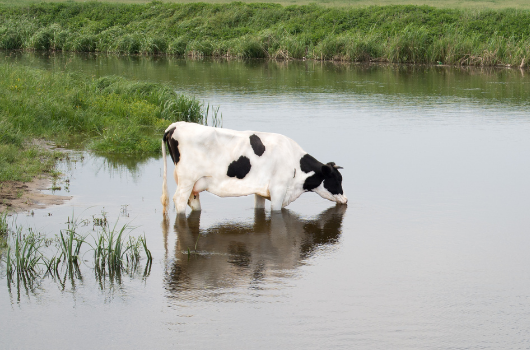
Addressing the water challenge
The issues of water and agriculture are intertwined – without water there is no farming. Therefore, to tackle the challenge of food security, the challenge of water has to be met first.
In this context of global water scarcity and food security concerns, water footprinting is emerging as an important sustainability indicator in the agricultural and food sectors. There are different alternatives in methodologies alongside ongoing efforts to develop a standard in water footprinting. Water footprints can focus on different goals, such as water quantity or quality. Meanwhile, different tools exist to understand and account for water use along the supply chains and risks related to it.
LCAs for water footprints
A product water footprint is usually based on Life Cycle Assessment (LCA) methodology, incorporating both direct and indirect water uses.
Calculation of the water footprint of a product using LCA methodology should be based on the ISO 14000 series, specifically ISO 14040, ISO 14044, and ISO 14046. In conformance with ISO14046 and to answer the needs around the issue of water, the assessment should take into consideration water consumption and water degradation.
A decision to calculate the water footprint of a product is a conscious decision to focus on one environmental issue at a time.
Other environmental impacts such as greenhouse gas emissions or land use should be taken into consideration, when possible, to address the environmental impacts of the global dairy sector in a holistic manner.
IDF work on dairy water footprint stemmed from a the need to clarify figures resulting from the differing methodologies and data is leading to inconsistent results, incongruent interpretation, uncertainty in decision-making, and communication challenges.
This represented a real danger of confusion and contradiction, which in turn could create a false impression that the sector is failing to actively engage with the issue of water consumption and degradation.
IDF guidelines on water footprints for the dairy sector:
- Increase understanding about the concept of water footprint assessment
- Provide transparency about the product’s water profile within its life cycle
- Enable monitoring, quantification, and evaluation of the potential environmental impacts related to water use from cradle to the manufacturing gate out, both in terms of quantity and quality
- Orient the identification of “hotspots” (areas targeted for consumption reduction)
- Measuring progress on the actions taken to improve efficiency.
For more information, read Bulletin of the IDF N° 486/ 2017: The IDF Guide to Water Footprint Methodology for the Dairy Sector
Learn more about environment
The breadth of issues IDF covers in its work is extensive. Find out more about the work we do
Life cycle assessment updates
Calculating the environment impact of dairy through environmental life cycle assessments.
Read MoreEcosystem services
Ecosystem services may be defined as the benefits to humans from nature or, direct and indirect contributions of ecosystems to human wellbeing.....
Read MoreInnovative solutions for sustainable dairy processing
Providing a comprehensive overview of eco-friendly & innovative dairy wastewater treatments.
Read MoreRelated reports & publications
IDF provides a permanent source of authoritative scientific and other information on a whole range of topics relevant to the dairy sector.
Related news & insights
IDF provides a permanent source of authoritative scientific and other information on a whole range of topics relevant to the dairy sector.
Accelerating climate action in dairy, by Dr María Sánchez Mainar
The United Nations COP 27 on Climate, which will take place this November in Egypt, will be an opportunity to discuss agriculture and food systems....
